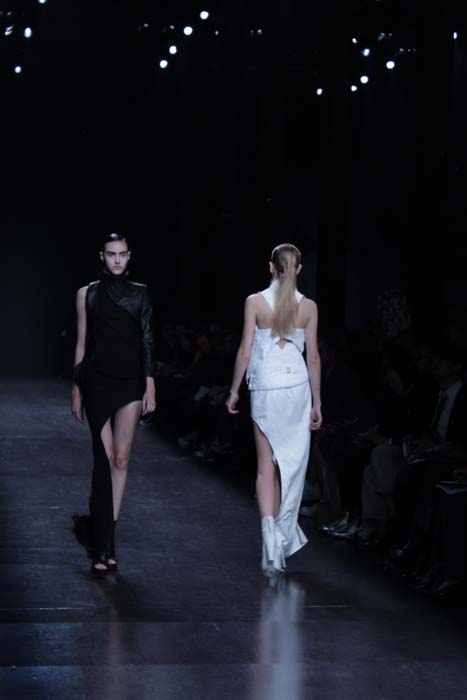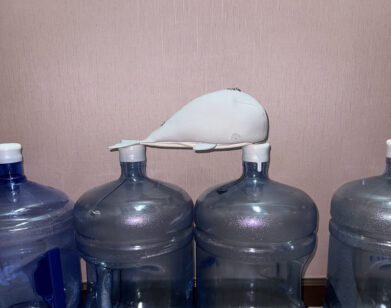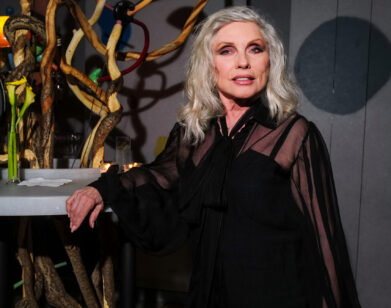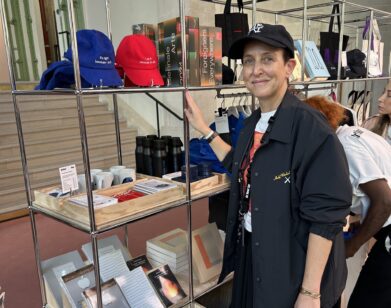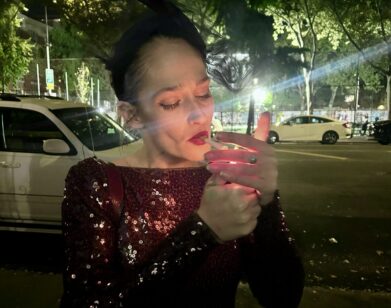Backstage Backstory: Ann Demeulemeester
In the mid-1980s, Ann Demeulemeester, star of the Antwerp imports, went against the grain: while women’s bodies were on display, the lady in black layered and draped, proposing an alternative to the ideal. We sat down with the designer backstage minutes before her show, held early in the afternoon in a convent on the Parisian Left Bank. There, Ann calmly talked about her evolution since her first designs in the 80s, her love of music, and staying true to herself.
ALICE PFEIFFER: What is the Spring 2011 show all about?
ANN DEMEULEMEESTER: I would call it “Graphic Abstraction.” It’s an evolution. Every collection is a new step and I really felt ready to open a new register moving towards something pure, clear, graphic. But, at the same time, with abstraction.
PFEIFFER: How do you express this abstraction ?
DEMEULEMEESTER: By abstraction, I mean I worked with prints, which I made gigantically big, and then I cut them. All the pieces therefore come out differently, and it doesn’t feel like a print anymore. It’s not a graphic art thing, I like the idea that all the pieces are unique.
PFEIFFER: In the 1990s, the woman you created moved away from the then frequent, hyper-sexualized look. Today, more people have moved in that direction. How do you remain contemporary and unique?
DEMEULEMEESTER: I’m very aware of the influence I’ve had, and I’m very pleased with that, because it proves that my work was necessary, that people liked it, and that it was right for its time which is a big compliment. But of course, this means I now have to move on. If more people are doing what I’m doing, I have to evolve. I’m pushed toward a new direction, and I have to let myself be tempted, find out where I can go.
PFEIFFER: Does it feel like a forced, or organic evolution?
DEMEULEMEESTER: No it’s nice, natural, it’s never “been there done that,” my work remains very interesting without losing my soul—because it’s really me, and I am always honest with myself. I don’t care what’s in or out, I just listen to myself. And it’s very nice to able to work like that. At the beginning people might have wondered what I was doing, but now they know my line, my evolution, I’m respected for that and that’s a wonderful feeling.
PFEIFFER: So who is Ann Demeulemesteer today? What are you keeping with you, what are you leaving behind?
DEMEULEMEESTER: I never leave anything behind. It’s like a history, a chain, a line of life, you just have to move and make new steps, and keep it evolving—but my soul is my soul.
PFEIFFER: You have worked with Patti Smith, and music has always seemed to be a great influence in your work—is that still the case today?
DEMEULEMEESTER: Yes. Music is very inspiring to me because “true” music releases a true energy that is just inspiring. It’s like when you see a beautiful painting or a wonderful film. You just receive this creative energy, and all of a sudden you want to create too.
PFEIFFER: What music are you listening to today?
DEMEULEMEESTER: It’s very very varied, it goes from electronic abstraction to violin, I just try to find interesting things. But of course I have my favorites who will always be there, I think you can guess what these might be!
PFIEFFER: Do you think fashion and women have fundamentally changed since you started? Which woman do you have in mind when you design today?
DEMEULEMEESTER: I don’t like to generalize; I don’t talk about the woman, because the woman doesn’t exist. We’re just lucky that we are able to choose. Those who feel like I do, who feel close to me find my product and find my soul. Each designer has a role to fulfill and you can never disappoint your audience, because it’s for them that you’re working. Naturally you always evolve, but my collection is about soul, about power.
Backstage Backstory: Ann Demeulemeester
It’s hard to think of a woman in fashion who is more cult-worshipped than AnnDemeulemeester. The Belgian designer started her own label in 1987 and introduced her menswear line in 1996. The longevity of these lines alone should confirm her as a battle-tested bellwether on the sartorial landscape. That she is, but the 49-year-old Demeulemeester still remains something of a rebel, and it just might be because her clothes always feel as if they exist in their own time—they don’t jump trends, and they don’t pander to flash or Top 40 tastes. They seem to survive on the strength of their cuts and shapes. Particularly in her menswear, Demeulemeester has carved out her own idiosyncratic urban-poet architecture: lots of layering, heavy on blacks and whites with an occasional breakout pop of color, and a sort of moody romanticism, all of which explains why so many musicians fill their closets with her clothes. One such musician is30-year-old New York–based guitarist, keyboardist, and a whole lot else, Jamie Del Moon. On the outside, Del Moon is something of a model-turned-musician, but each season, for Demeulemeester, he flies to Paris to become a musician-turned-model. Del Moon first walked for the designer in her Spring/Summer 1998 show—it was, in fact, his first big show ever, as he was straight off the plane from his hometown of San Francisco. “Within a week of my arrival in Paris, I had the good fortune of meeting Ann,” Del Moon remembers. “The encounter would mark the beginning of a long and mutually inspiring relationship that continues to this day, with no end in sight.” Almost every season Del Moon has returned to work for his favorite designer and to be a part of her army of rockers and artists. The shots of his runway walks (seen here) record not only a teenager growing into a man (with obvious hairstyle changes along the way), but also the progression of Demeulemeester’s meticulous look, with one guy in particular in mind.
ANN DEMEULEMEESTER: You’re in New York now?
JAMIE DEL MOON: Yeah. I’m at my new house in Brooklyn. I’m staring out into my backyard, which is completely covered in snow. But you have gardens in Antwerp. I loved those prints you made a few seasons back, when you scanned flowers that you and Patrick [Robyn, Demeulemeester’s husband] grew in your garden. That was such a personal touch.
DEMEULEMEESTER: Well, I was frustrated that I couldn’t find fabrics with colors as beautiful as the ones you find in nature. So I just thought, Okay, let’s take a photo of nature and try to print it. And that’s what I did.
DEL MOON: You’ve always had a very closerelationship with music. It’s prevalent during your shows, where you manage to create your own universe of clothing and sounds, all floating together. Your music selection is impeccable—Patti Smith, Television, and, most recently, Warren Ellis. Why is music so important to you in your work?
DEMEULEMEESTER: It’s important for many reasons. Creating is a lonely thing, in a lot of ways. I also always try to capture something and explain it through my work. When you see or hear something beautiful, it’s like that thing is transmitting a kind of energy, and if that energy helped create the work, the only thing I can do is play it when I finally show the work. It’s almost like I own the music, because the music brought me somewhere. It’s based on a feeling, and I always follow my feelings.
DEL MOON: So the music ultimately becomes part of the collection?
DEMEULEMEESTER: I don’t know if it’s part of the collection, but it’s a beautiful way of bringing different emotions together. I don’t know how to explain . . . And maybe that’s what music does, you don’t need words. You must understand because you are a musician yourself.
DEL MOON: I think I get what you’re saying. One thing I’ve always noticed about your shows that’s different from other designers is that there isn’t this hysteria and chaos going on behind the scenes right before it starts. There is an actual sense of calm and order, like a family affair. And it is a family affair, because you have Patrick there, and your parents come, too.
DEMEULEMEESTER: Yeah . . . [laughs] My father hasn’t missed a single show yet. I don’t see why one should make all that fuss, you know? I just try to do my work and do it well. I hate stress. If you create that kind of calm environment, people will say, “Okay, we know where we stand, and this is the maximum I can give, and let’s see what happens.” If they like it, great. If they don’t, at least I’m happy with what I did. I just don’t like to play games.
DEL MOON: You have the new line out now that’s sort of a reissue label, where you’re reintroducing pieces from the past.
DEMEULEMEESTER: Yes, it’s called Collection Blanche, or White Collection. It’s white because it’s blank, without any identifying dates. I did it because people kept saying things like, “Oh, I loved those trousers. Can’t you make ones like them again?” Or, “I love my jacket, but it’s falling apart. I want the same one.” It’s because certain pieces of clothing become like friends. They become a part of your life. You can’t stand it if, all of a sudden, they are gone. I wanted to do this collection because it was like going back and finding old friends for me, too. It was great to go through the archives and say, “Wow, why don’t we make this again?”DEL MOON: You did your first collection in the late ’80s and your first menswear collection in the midâ??’90s. Do you think it’s harder for designers just starting out now than it was for you when you began?
DEMEULEMEESTER: It’s never been easy. When I think back on what I did, it wasn’t like I waited until god fell out of the sky to help me. I just thought, If I want to do something, let’s do it. I had a lot of patience and went step-by-step. I made a little rack of clothing and I did it all by myself. I think, theoretically, yes, it may be more difficult to start today with the way things are. But I don’t like to say that, because I believe that if you have something to say, then you just have to do it. Good work finds its way in whatever time you’re in. If you want to start, then start, and don’t find a million excuses not to. It’s always a difficult time. When was it easy?
DEL MOON: I remember this really wonderful story you told me about when you were first starting out and you and Patrick found the Le Corbusier house in Antwerp but you didn’t have enough money to buy it. The woman who was selling it . . . Wait, what was the story about her father?
DEMEULEMEESTER: [laughs] She said to us that she had a dream that there was a man walking in the Le Corbusier house, and she wasn’t sure if it was her father or Patrick, but for some reason she felt like the house was built for either her father or for Patrick, so she wanted us to have it. She thought it was a sign, even though we had no money.
DEL MOON: So you took it.
DEMEULEMEESTER: Yeah. It’s crazy—some things happen in your life that you couldn’t believe would ever be possible. But they’re meant to. This house has had a serious influence on me. It is so calm and has beautiful light . . . just this simple beauty. I couldn’t have created and worked the same way if I had lived someplace awful. I’m sure of that. It has nothing to do with money or luxury. It’s about what’s essential and the beauty of something humble. In a way, the biggest luxury to me is nothing.
DEL MOON: It’s funny to see the photos of me modeling for you over time. There is a real consistency to the collections over the years—and not so much consistency in my look.
DEMEULEMEESTER: It is strange to see all these moments of our lives in the pictures! It’s really nice to see. My favorite one is definitely Holy Jamie from Spring/Summer 1998. [laughs]
DEL MOON: I think I got some confidence over the years. I remember how nervous I was the first time I walked the runway for you. That was my first big show. I felt like I didn’t know what I was doing.
DEMEULEMEESTER: Well, we never quit, did we? We found each other and it was so natural for me that you were part of it. The way you do my show, the way you move, I was always touched to have you modeling for me. You have added a lot. It’s important to say that after so much time.
DEL MOON: Of any designer’s clothes, I’m probably most comfortable when I’m wearing yours.
DEMEULEMEESTER: Yeah, well, with you it’s not like you’re a model—you’re Jamie wearing my clothes. But they aren’t my clothes anymore. They are your clothes, and that’s why they come alive, because they lock into the way you are, and it looks right. It doesn’t look organized, it looks honest. And that’s the most important thing for me—honesty.
See the archives of Ann Demeulemesster here.

